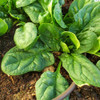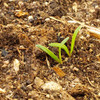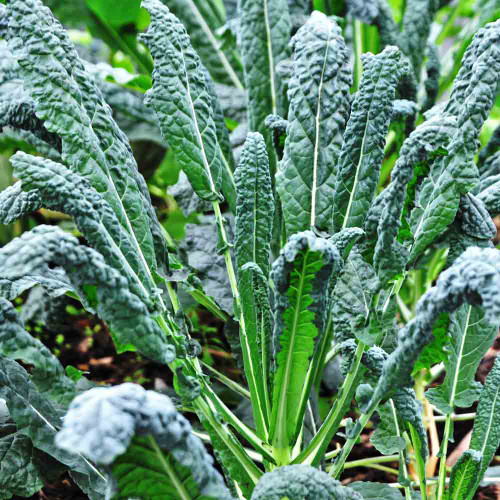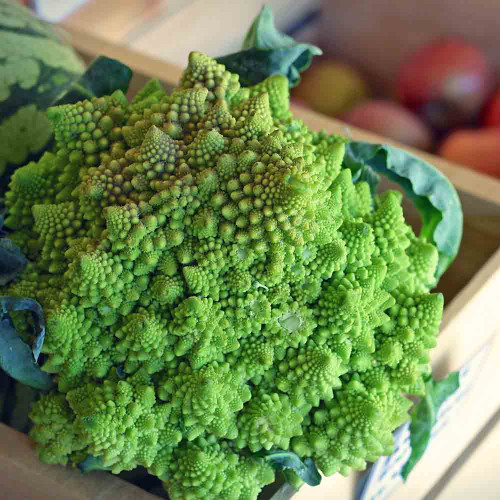Description
Giant Nobel Spinach - Taste of Royalty
With its large, green, thick, gently savoyed leaves with rounded tips and almost sugar-sweet, thin stems, Giant Nobel - also known as Giant Noble or Giant Noble Spinach - is the best of the thick-leaved varieties. Hardy, vigorous, and resistant to bolting, it has been a consistently reliable producer and a garden favorite for almost 100 years.
It is an excellent early and late-season choice, one of the few spinach varieties that do well in cold and heat. It becomes sweeter with cooler weather yet tolerates the heat longer than many others, resisting bolting and becoming bitter.
Details
Giant Nobel spinach certainly earns its name with impressively large triangular to spade-shaped leaves, and the plant often exceeds 2’ wide. Featuring prominent veining with a lightly savoyed texture, the leaves are dark green and thick with a subtly chewy, tender, and succulent crispness. They are mild with a slightly sweeter flavor than ordinary spinach, mixed with a pleasant minerality.
Since its introduction in the Netherlands in 1926, Giant Noble spinach has earned enduring popularity with home gardeners and market growers. Gorgeous looks and sweetly flavorful taste back its consistently robust production. It won the “All American Selection” prize in 1933 and remains a popular spinach today.
History
A vegetable’s name often tells about its history, and spinach is no exception - the word “spinach” is originally from the Persian word “aspānāḵ,” which became “ispanai,” meaning “green hand.” As it was traded and traveled, it later became “spanachia” in late Latin and then “spinach” in English, from the late 14th Century Old French “espinache.”
There are two schools of study on the origin of spinach.
One theory describes Persia as the center of origin with its introduction to China in the 7th Century, where it was known as the “Persian green.” Trade and exploration brought it to Europe sometime in the 12th Century and then to the US in 1806.
The other theory places the origin in Nepal, descended from Spinacia tetranda, a native wild edible green. In 647 AD, it traveled to China as a gift from the King of Nepal, where it was still referred to as the “Persian green,” and then introduced into Spain by the Moors of North Africa in the 12th Century. Spinach was known as the “Spanish vegetable” during the Middle Ages but didn’t become a Mediterranean staple until the 1400s.
Catherine de Medici of Florence, Italy, made spinach famous through her love of it, as she reportedly ate it at every meal. When she married Henry II, the King of France, in 1533, she brought her cooking staff along so they could properly make the spinach dishes she loved. She inspired the phrase “a la Florentine,” describing dishes prepared on a bed of spinach.
Soon after its introduction to US gardeners in 1806, spinach became immensely popular from the 1800s through the early 1900s. After commercially grown canned and frozen spinach ruined the taste for a couple of generations, fresh spinach is again popular.
The Giant Nobel cultivar originated in Voorburg, The Netherlands, from breeding trials conducted by Zwaan and Van Der Molen in 1926. The history of spinach breeding throughout the 18th and 19th centuries is primarily unknown, as seed breeders and companies kept their research private.
Uses
Giant Nobel spinach has a mild, sweet, and green flavor, ideally suited for fresh and cooked dishes. The leaves are great tossed into salads or as a lettuce replacement and add depth of flavor shredded and topped on pizzas or lasagna. Wash and lightly tear leaves, then layer onto sandwiches or add to fresh wraps or tacos.
The sturdy leaves hold up to cooking, wilted into pasta, stuffed into chicken breasts, or sauteed and topped over crostini with cheese as an appetizer. Lightly cooked, they flavor sauces and dips, omelets and frittatas, casseroles, and other hot dishes.
Pairs well with citrus, berries, nuts like almonds, walnuts, and pistachios, cheeses including parmesan, gruyere, and mozzarella, mushrooms, tomatoes, artichokes, and aromatics such as garlic, ginger, and shallots.
Companion Planting
Spinach grows well with broad beans like fava, celery, cilantro/coriander, dill, eggplant, horseradish, lettuce, onion, peas, radish, rhubarb, salsify, strawberries, and sweet corn.
Good companion flowers include cosmos, marigolds, nasturtiums, and zinnias.
Companion cover crops like Crimson clover in warmer summer climates will help keep the roots cooler and extend production time.
Avoid growing near potatoes.
Growing Tip
Spinach is a fast-growing, cool-weather crop that grows well when planted in successive sowings.
In colder climates, start planting your spinach seed in spring as soon as the soil can be worked, with successive sowings every two to three weeks until the heat of summer. Resume planting again in mid to late summer for a fall crop.
In warmer climates, spring plantings usually give one or two harvests before the heat arrives, so mid to late-summer plantings do better over a longer time. Start planting in mid to late summer with successive sowings every two to three weeks into late fall or early winter.
Spinach grows well in full sun in middle to northern climates and partial to deep shade in hotter southern gardens.
Because spinach is a cool-season crop, it doesn’t germinate well in warmer soils above 75-80°F. A shade cloth structure over the soil during warmer months gives better germination, robust growth, longer production, and less bolting. The flavor is noticeably sweeter with less bitterness in warmer weather.
Improve germination during warmer weather by soaking Giant Noble spinach seeds in water in the refrigerator for 24 hours before planting. The seeds take up water and begin the germination process. Water the soil well in the row where the seeds will be planted to soak it deeply, then plant the seeds about 1/4 inch deep.
Maximize your garden space by planting 8 to 10 inches apart.
Harvest Tip
You can harvest leaves throughout the growing season as a cut-and-come-again plant, but wait until the plant has produced at least 4 to 6 leaves—harvest by clipping the stems of the outermost leaves, leaving the middle leaves to develop.
You can also harvest it all at once, cutting at the base of the plant just above soil level like a head of lettuce.
Learn More
From the soil to the seed to the food you eat - we'll help you grow your best garden!
1 Review
-
Very hardy
We make sure to sow a little of this spinach every week. It survives light frost, and seeds dropped from bolted plants will start very early next spring. Nice crunchy leaves and mild taste. A must-have every year.

















